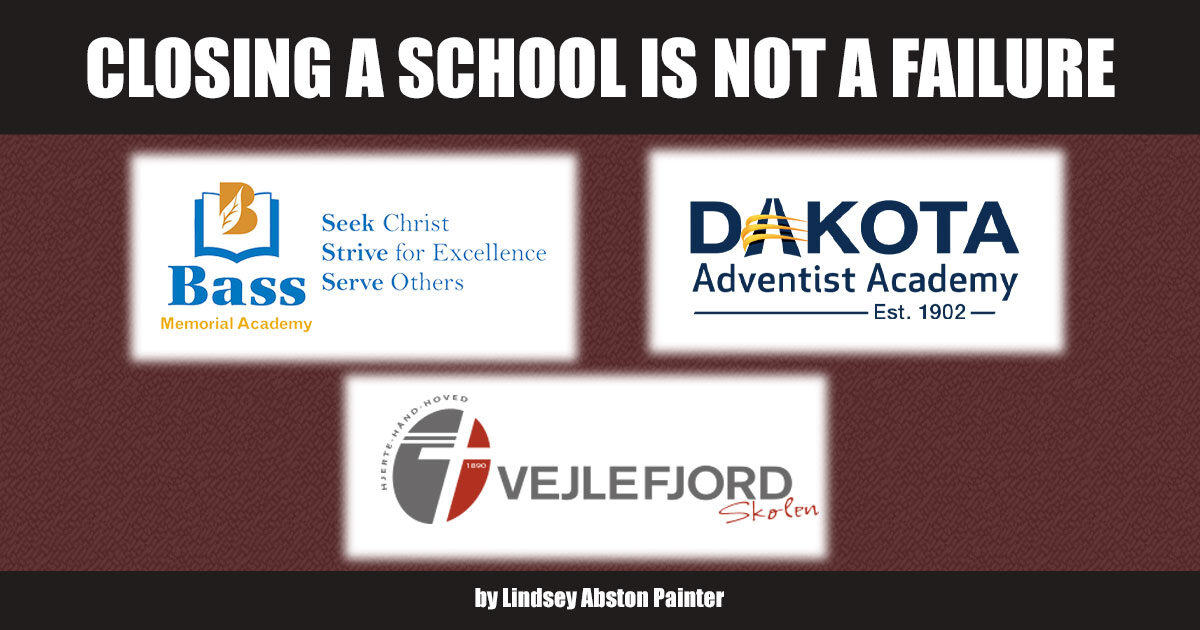It’s Been a Success—and Now It’s Ended
Lindsey Abston Painter | 4 April 2025 |
Recently Adventist Today reported on the possible closure of boarding high schools in North Dakota, Gulf States, and Denmark. These reports got a lot of response. Many people were understandably upset. Adventist boarding schools were once a successful and powerful way to educate children, to share with them the values of the Seventh-day Adventist Church.
But in recent decades parents seem to want their children at home longer, rather than living in a dormitory with a young dean in loco parentis. Families struggling financially in an uncertain economy can’t pay high private school tuition costs, instead sending their children to the public schools their taxes pay for. It has become increasingly difficult for boarding academies to meet their financial goals, and because they’re running on razor-thin margins, some will inevitably close.
There is a natural feeling of loss when these things happen. “How can these fine institutions,” we wonder, “once pillars of Adventist education, fail?”
But is this a failure?
Would closing these schools necessarily mean they’ve been a failure? I don’t think so. Children got educated there for decades. And now it’s over. We’ll have to find new ways to do that work.
The cycle of life on this planet is a cycle of beginnings and endings. Each year we see new growth in the spring and death in the autumn. Humans, animals, plants, and all living things are born, grow, decline, and die. Yet even as we understand that process to be a more or less natural cycle, we have difficulty applying that same reasoning to other processes. It is hard to accept that things that once served us well might serve us no longer.
When I got married in my 20s, my husband and I were in love. We were happy at the beginning. We had shared values and enjoyed each other’s company for many years. No, things weren’t perfect—but all relationships have some issues, and overall we had a relatively harmonious one.
Over time I began to question the values I’d been raised with, the church’s teachings, and my political stance. As my views changed and my husband’s didn’t, the differences between us came more into contrast. The issues that had always been there became pronounced. We argued more. We listened less. We became resentful.
As time went on it became clear that we no longer had shared values. We tried everything—we really fought hard to save our marriage. But forcing ourselves to continue to be married was causing harm to ourselves and each other. It became increasingly obvious that our attempts to fix our marriage amounted to one of us having to fundamentally change everything about ourselves to accommodate the other. And the day came when we decided that the marriage needed to end.
Most people would consider that a “failed” marriage. And for many years that is how I thought of it.
Eight years have gone by since my divorce. I am pleased to report that I have found my ex-husband to be an excellent co-parent. He is a good father. He shoulders his share of the burden (and joy!) of raising children. We go out of our way to help one another with schedule changes. We share child-rearing costs. He even helps me haul stuff occasionally when I need to borrow a pickup truck. We care about one another. He is a not-insignificant source of support.
We do not discuss politics (when we can avoid it), and our daily activities and choices demonstrate that our shared-values-issue still persists. We cannot be married to each other.
But was our marriage a failure? I don’t think so. Our marriage was a beautiful thing. It was born of love. It produced two amazing children.
And just like all living things, when it was time for it to end, it did.
A success that ended
Our world would be better if we could view more things like that. Cursive is dead, and keyboarding is indispensable. Football causes concussions and brain damage—though it was fun while it lasted. The great music of the ’60s, ’70s and ’80s is now “oldies”—still good, but the creators are dying, and we are left only with recordings and memories. The same with the classic cars of those eras, with their rumbling V8 engines and vinyl tops: now, our cars are quiet and efficient computers on wheels. Your favorite restaurant opens, runs for awhile, and one day when you drive up to it it is sporting an “OUT OF BUSINESS” sign.
As for our church, old evangelistic methods such as mass mailings of The Great Controversy, traveling evangelists, and Revelation Seminars will never again work as well as they once did.
I don’t know a lot about these specific boarding schools, but I do know that their stories are likely more nuanced than they seem to an outside observer. One thing I can affirm about them with some certainty, though, is that their stakeholders are having a hard time letting go. Alumni of the schools and parents of recent students can’t imagine their world without their alma mater—and I understand that.
Humans tend to fall into the sunk-cost fallacy: “the phenomenon,” according to the Oxford English Dictionary, “whereby a person is reluctant to abandon a strategy or course of action because they have invested heavily in it, even when it is clear that abandonment would be more beneficial.” It is likely that the host conferences of these schools have been trying to save them for a long time. Prayers have been flying up to heaven. There have been many financial appeals—endless requests for “sacrificial giving,” to which generous people lovingly responded.
And then, after all that, the leaders still had to say, “Sorry, but it wasn’t enough!” But by now, so much money and emotional energy has gone into these schools that it makes the loss feel even greater.
On this earth everything moves in a cycle. This is a biblical principle: “There is a time for everything, and a season for every activity under the heavens: a time to be born and a time to die” (Ecclesiastes 3:1-2). These schools had their birth, their growth, their years of success, and now a decline—and it may be time for them to die. Resisting the natural life cycle will likely be a losing battle. As a treasurer of one of the conferences told the constituency, “Yes, you can spend all of our available money on keeping that tiny handful of students in this school. But just know that in two years you won’t have a school, you won’t have the money, and maybe not even a conference.”
The failure to recognize this in a timely way, as we should do more often, has resulted in a lot of money from sincere donors being sunk into dying and ineffective institutions and methods. It leaves a lot of people very upset when the inevitable happens. Some blame the leaders, and get angry. We dislike change, and it’s easier to cling to the things that we know, things that we understand. It’s scary to launch into the unknown, to try new things, to take risks. It’s hard give up places that have meant a lot to us, institutions that have served us.
But when something has run its course and no longer serves us, the wisest thing to do is to let it go. It’s been a success—and now it’s ended.
 Lindsey Abston Painter is a teacher, and a member of the editorial team of Adventist Today.
Lindsey Abston Painter is a teacher, and a member of the editorial team of Adventist Today.
To comment, click/tap here.




